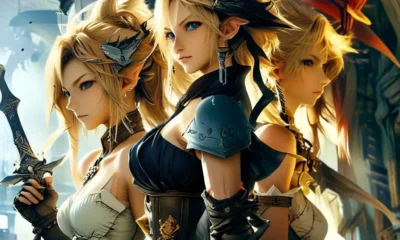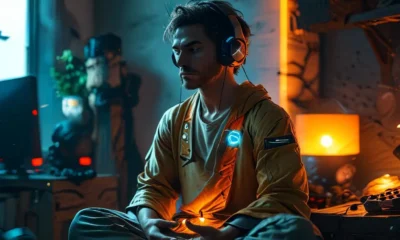Features
‘Final Fantasy XV’, Game Preservation, and Evolving Art
Hajime Tabata – the director of Final Fantasy XV – recently announced that Square Enix will be tinkering with the story of the game both in the short term and in the long term via free updates. Updates aren’t unheard of in 2017. Games are frequently patched on day one to fix all of the things that probably shouldn’t have been broken in the shipped product in the first place, and sometimes, games are patched before they’re even released at all. I’ve played multiple games in my capacity as a reviewer that have received updates before the release date has hit – sometimes numerous updates – meant to fix problems that the developer either identified once the game went gold, or that they knew about before they shipped it and decided to just sort out down the road. Then once the game reaches the public eye, reaction to the title might prompt further updates from the developer to fix bugs, mess around with balancing issues, or even add in new features at the behest of the community.
The software that ships on a disc is no longer the final version of the product, but while the fixes and updates developers traditionally apply to their games are mechanical or feature-based, the latter of which are generally devised as a method of extracting a little more profit from games that are already on the market, Square Enix is proposing a far more drastic set of updates that will significantly alter the narrative of Final Fantasy XV in order to improve it over time. This intention, while ostensibly noble in the desire to improve an already sold item for no profit in the name of what is presumably artistic integrity, is interesting, exciting, and troubling in equal measure.
At its core, the driving force behind creating a piece of art has never really changed. The artist wishes to create something, be it visual, aural, or another singular or combined form of sensory stimulation, for the purposes of evoking some kind of emotional response from the consumer. It doesn’t matter whether the words of Shakespeare are printed on parchment, a cheap paperback, or emblazoned across the side of a double-decker bus – the original artistic statement remains unmolested, and only the distribution method has been altered.

Backstreet’s back, alright!
As the powers of our technology have increased exponentially over time, so too have the options afforded to artists when considering how they would like to disseminate their art amongst the populace. When the first, ancient Greek thespians began performing plays for the inhabitants of small villages, live performance was all they had. Today, acting is still performed in theatres in a method analogous to those early dramatic performances, but we also have radio plays, television mini-series’, and Michael Bay movies. Over 2,000 years ago, Aristophanes would have found it inconceivable that in the year 2017 a popular method of dramatic storytelling would be blowing things up in slow motion while Linkin Park songs play in the background but then I suppose many of us living through it today are equally dumbfounded.
Importantly, technology has given us the gift of recording entertainment for consumption in the mass market. While many will lament that listening to John Coltrane on Spotify while you’re driving to work will never compare to sitting in a smoky jazz club in New York in ’63, the fact remains that our ability to capture performances and distribute them to people who might otherwise have never been able to experience them is one of the great feats, artistically speaking, in our history. Evolving technology has allowed artists to reach more people than ever before, from recording movies to film to eventually dispersing comic books across the Internet to be downloaded to a smart phone in the blink of an eye, preserving the work of these artists in perpetuity, to be passed on to later generations long after the creator has passed on.
But for all of the advances in technology, storytelling, be it via giant CGI robots fighting while Megan Fox pouts, or old men in robes standing in a village square reciting sonnets for an audience, is philosophically the same as it always was. The village squares have been replaced with IMAX and overpriced nachos, that’s all.

“Yeah, so really, it’s no different to King Lear, except we filmed Megan Fox bending over a lot.”
Video games are a relatively new form of entertainment, and though many would still deride gaming as being bereft of artistic merit – even famed movie critic Roger Ebert once famously opined that games would never be art – the fact remains that gaming has proven itself as a viable art form in the handful of decades since Pong first appeared in arcades. People scoffed at movies back in the early days of cinema as a form of entertainment for the peasants and the plebeians; scores of poor dullards, transfixed by shiny moving pictures on a big, bright screen. Rock and pop music were similarly dismissed by critics at their inception, while classical and jazz were considered the connoisseur’s choice for aural delights. As the older critics retired, they were replaced by younger versions that had grown up enjoying these once stifled genres or art forms and as a result, movies and rock music became more popular and more respected; the dinosaurs had to die out in order for art to evolve.
Part of the reason that those largely unfamiliar with video games seem to struggle to accept or even fully understand what video games are is that the medium is wholly unlike most other forms of art that appear in mainstream culture. Books, movies, music, comics, painting, sculpture, theatre, and most other appreciated and respected art forms are entirely passive mediums, but video games are not.
It doesn’t matter how many times you watch Back to the Future, where you watch it, who with, or the size of the screen you’re watching it on. Nothing changes about the movie between viewings, and while the company you keep might make the experience altogether more enjoyable on a particular screening, or a noise outside might ruin it for you on another, the piece of art remains stoic. The same can be said for most traditional art forms. Video games, by their very nature, are entirely different because in order to meet the criteria for the definition they must include some form of interactivity, however slight that may be.

“It’s your kids, Marty! Something’s gotta be done about your kids! They’re still waiting for Final Fantasy XVI!”
Interactivity is an odd beast because one can never truly know what another person is going to think or do. A skilled director can make sure that the story beats and emotional highs and lows of a rip-rollicking 1980s time travel adventure movie hit all of the right notes, but even the most seasoned video game director can’t anticipate when the player will accidentally walk their avatar off of a cliff. The role of the player is integral to the success of the artistic statement at the core of any video game, and it’s in this regard that gaming as an art form is relatively unique.
While many video games strive to replicate the thrills and spills of an action movie, interspersing gameplay sections between cut-scenes that elaborate on the narrative, some embrace the interactive nature of the medium to spin unique yarns that couldn’t be replicated in a passive medium. A game like BioShock, for example, couldn’t resonate to the same degree as it does were the story translated to the silver screen because the narrative of the game is so intrinsically tied to the very idea of interactivity and player agency. As a movie, BioShock would be an interesting, dystopian adventure with a little to say about the nature of morality and a distinct whiff of Ayn Rand. As a game, BioShock offers a thought-provoking commentary on the nature of control that is widely regarded as one of the shining examples of how gaming as a medium can push buttons that other art forms simply can’t touch.
Video games also differ from other forms of art because, as the most recent major entertainment medium, they’re at the forefront of technological advances in ways that other art forms haven’t yet fully embraced. Traditionally speaking, once a movie or a book or an album is released, it exists as the objectification of what the creator deemed to be their artistic vision at that moment in time. OK Computer by Radiohead sounds exactly the same today as it did back in ’97. Once the artist’s brush leaves the canvas for the final time, their painting is finished, and it will never change barring disaster, erosion, or vandalism. There are examples of artists changing their work over the years – be it the seven various cuts of Blade Runner, or the Harry Potter books being re-released with illustrations, but for the most part, once a piece of entertainment has been released, those responsible for it move on to other projects.

If I ever win the lottery I’ve always thought I’d get a massive statue of myself built outside my house, too.
Video games were – before the advent of the Internet – analogous to movies, only in interactive form; once they were released to the public they were a finished article. The Internet has afforded video game developers unique opportunities as an art form. If the world created by the developer contains an error, or if a little too much action on-screen causes the game’s frame-rate to struggle, the developer can conceivably alter the code and then deploy a patch to be downloaded – automatically by today’s consoles – that will then change the experience for the user without them having to actually do anything. Between playing a video game one day to the next the title could have been changed, perhaps subtly, or sometimes overtly.
There are examples of creators trying similar ideas within different mediums. George Lucas has been routinely eviscerated by many among the Star Wars fandom for years for frequently and – let’s face it – unnecessarily changing aspects of the original Star Wars trilogy. George Lucas seemed determined to bring his sci-fantasy movies kicking and screaming into the modern era of cinema by adding obnoxious CGI creatures to scenes that resulted in the films looking every bit as natural as a baseball cap on a medieval statue, annoying long-time fans of the franchise in the process.
What was most important about George Lucas repeatedly altering the Star Wars movies of the ’70s and ’80s was that it became increasingly difficult to get a hold of the untouched, as released to cinema versions of those movies as VHS, DVD and eventually Blu-Ray copies tended to only include the post-tinkering versions. Lucas was, for all intents and purposes, rewriting history; he was removing his original films from mainstream, readily available circulation, and replacing them with his new artistic vision. People might have been disappointed with his changes to what are beloved movies, but few would go to the lengths of tracking down original VHS copies of the films and hooking up a VCR just to watch them for the sake of not having to deal with a few badly implemented CGI additions to what is largely the same picture as before. In effect, the new versions of Star Wars have overwritten the originals in the eyes of most.

From Star Wars to Kanye West: quite literally, from the sublime to the ridiculous.
Similarly, last year Kanye West released his latest album, The Life of Pablo, but since then he’s been systematically changing songs – tweaking mixes or in some cases adding or removing guest vocals or entire tracks – and for those listening to the record on streaming services like Spotify, the version that was first released is no longer available. For those who bought a copy of the album on compact disc the music contained within it has never changed, but in a world increasingly reliant on the Internet and streaming for their entertainment needs, whatever The Life of Pablo was upon release has been forgotten in favour of whatever version Kanye West decrees to be the most up to date one.
The Life of Pablo and Star Wars are prominent examples of evolving art; pieces of entertainment that have been refined or tarnished – depending on your perspective on the matter – by creators that have perfectionist mentalities and access to technology that allows them to fulfill their compulsive desire for improvement. But what of preservation, and of the importance of retaining the original work of art, as it was at the moment of its completion, and as it was enjoyed by people at that time. For somebody that had never seen Star Wars since 1977, reflecting on their favourite aspects of the movie with someone seeing it for the first time in 2017 would be an odd experience, as a favourite moment as enjoyed by one of the people in question might not even be present in the version that the other person watched. Case in point, my favourite track on The Life of Pablo wasn’t even on the original version released to the public.
Imagine that Leonardo Da Vinci had somehow discovered the secret to immortality, and in 2017 he decided that he didn’t like the Mona Lisa any more and he wanted to give his old painting a spruce up. That’s his prerogative as an artist. Ultimately, he created the piece, and if he wants to change it then he should be allowed to alter it as he sees fit. But what would the world lose once he had changed it? As a piece of art the Mona Lisa is one of the most famous paintings in the history of our species, but in the blink of an eye it could cease to be, replaced by a painting that regardless of its eventual quality, would exist at the expense of the revered work that came before it. It’s hard to know where the balance between freedom of artistic expression and the preservation of important works of art should lie, and that’s the difficult quandary that video games face if Square Enix’s changes to Final Fantasy XV become something that other studios embrace going forward.

“Alright Leo, I see what you’ve done here. Just a couple of minor quibbles…”
While the most prominent example of the refinement of video games via post-release patches is the fixing of bugs or DLC adventures sold at a premium, there are examples of a studio altering a game in order to improve the narrative before now. The most famous example of this was when Bioware changed the ending to Mass Effect 3 after the original conclusion to the trilogy resulted in heartbreak and uproar from many of the most ardent fans of the franchise. Commander Shepard’s final hurrah was widely considered to feature an ending that was at best somewhat rushed and overly brief, and at worst a confusing, cynical and anti-climactic mess. Bioware responded to the fan backlash by offering a free update to the game that didn’t change the ending of the story conceptually, but did elaborate and further explain many aspects of it, as well as offering greater closure to the story of Shepard and the rest of the prominent characters in the series.
In essence, Bioware didn’t alter the story of Mass Effect 3 in any meaningful way. What they did was alter how that story was delivered to the player in order to make it more palatable to the fanbase. Square Enix is proposing numerous updates to Final Fantasy XV going forward that seem destined to radically change the story of the game in light of what many people critical of it deemed as a somewhat disappointing narrative. In order to satiate those gamers, and for the studio to live up to the high standard expected of a game bearing the Final Fantasy name, Tabata and Square Enix want to add to the game and subtract from it. By the time they’re finished, the title will likely be a very different creature to the one that most of us played late in 2016.
As somebody who played Final Fantasy XV and largely enjoyed it, but thought that the story of the game was muddled, badly delivered, and featured numerous characters whose motivations were never really clear, I do wish that the game had shipped with a more refined narrative. But at the same time I recognize that Final Fantasy XV is, culturally, a very important game, thanks in part to the legacy of the series going back to the 1980s, and in part due to the troubled nature of its development and the weight of expectation levied upon the game because of it. Is it not important to retain what Final Fantasy XV was upon release, so people can look back and see how the story of the development of the game eventually paid off?

Mass Effect 3’s original ending paid a disservice to a cast of characters that many gamers had grown to love over the course of three games.
For those who bought a copy of the game on disc, they’ll forever have a time capsule version of Final Fantasy XV that serves as a reminder of how the game shipped in 2016. And after the updates come, all they’ll need to do is delete the game from their console, and reinstall it without patches to play the game as it was released. But in a world in which many gamers are switching to digital distribution as their method of choice for purchasing video games, any changes made to the narrative of Final Fantasy XV and delivered in patches will be automatically included in the download file of the game going forward. Effectively, for gamers who buy digital, the original version of Final Fantasy XV will cease to exist, and the new version – whether it’s better or worse than what came before – will be all that’s available.
As gamers move ever closer to fully embracing the all digital future of video gaming, this sort of post-release updating of games will, presumably, lead to many original versions of games being lost to time. We can still plug the original Final Fantasy cartridge into an NES and play it as it was intended to be played back in 1987. By the time Final Fantasy XVI or XVII hits, will physical media even exist beyond part of limited edition packages released solely for collectors? And will updates result in video games evolving over time at the expense of the version of the game that came before, with each reinvention of the title causing the previous iteration to be lost in the electronic ether?
As somebody who creates on a semi-regular basis – as a writer in various forms and as a podcaster – I can understand the regret that comes with finishing a project. I’m writing this article at this very minute, and hey, I know it’s not exactly Michelangelo putting the last lick of paint onto the ceiling of the Sistine Chapel, or the final scene of Bill and Ted’s Excellent Adventure when Rufus plays that kick-ass guitar solo, but it’s a creation none the less. It’s a piece of writing that will eventually be sent to an editor who’ll pretend to read it, publish it, and then get back to watching funny dog videos on YouTube. Hours later I’ll be giving it a read over to reflect upon it – mainly to see if there’s any comments on the article being mean about me – and I’ll see a sentence that’s awkward or goes on way too long or is overly loquacious or features too many redundant non-sequiturs or there’s a fancy word used incorrectly or it’s perhaps just a little too meta for its own good, and I’ll think to myself that I could have done a better job than I did.

This isn’t the Michelangelo I was talking about, but if I’m honest, I prefer this one.
It’s an uneasy feeling that comes with the territory when you’re putting anything that you’ve worked on out into the public eye to be judged. You can be proud of something, perhaps even elated if you believe that the work has turned out better than you’d ever hoped it would, but you’ll rarely escape the niggling feeling that there’s something, anything, that you could have done a little differently that would have made it better. I write articles about video games and I get that feeling. I can’t even begin to imagine what it must be like creating Star Wars and then wishing that you’d made Greedo shoot first.
Anybody who has ever created anything, whether it’s a movie script you’ve written or a finger painting you made when you were in school, can understand that feeling, however small, however inconsequential, that you could have improved it. And so it’s easy to sympathize with the artist that revisits their work in order to refine it and get it a little closer to their artistic vision. But at what cost?
Video games are here to stay, and in thirty years time they’ll be far more respected as an art form than they are today. Video game historians will look back at the period of gaming that we’re living in with the same reverence and intrigue that many movie experts have for the early days of talkies today. Gaming is evolving, and growing, and the boundaries of the medium are forever being tested, be it by seismic changes to control like the kind being spearheaded by many Nintendo products over the years, or by challenging what the nature of a video game can be as with titles like Gone Home or BioShock.
When those historians look back at our time, it’s incredibly worrying to think that when they talk about the infamous, tortured development of Final Fantasy XV, they might not be able to lay their hands on a copy of the game as it was released, but will rather have to settle for an updated version that was finished whenever Square Enix stopped patching it. For bigger games like Final Fantasy, this might not be a huge problem as physical copies will undoubtedly survive, and copies could be made going forward. But for games released digitally, evolving art is an exciting prospect for consumers looking for titles that will improve over time, and a terrifying concern for game preservation, and the importance of art as a reminder of a time long since passed.

-

 Features4 weeks ago
Features4 weeks agoDon’t Watch These 5 Fantasy Anime… Unless You Want to Be Obsessed
-

 Culture3 weeks ago
Culture3 weeks agoMultiplayer Online Gaming Communities Connect Players Across International Borders
-

 Features4 weeks ago
Features4 weeks ago“Even if it’s used a little, it’s fine”: Demon Slayer Star Shrugs Off AI Threat
-

 Features2 weeks ago
Features2 weeks agoBest Cross-Platform Games for PC, PS5, Xbox, and Switch
-

 Game Reviews4 weeks ago
Game Reviews4 weeks agoHow Overcooked! 2 Made Ruining Friendships Fun
-

 Features2 weeks ago
Features2 weeks agoThe End Is Near! Demon Slayer’s Final Arc Trailer Hints at a Battle of Legends
-

 Features3 weeks ago
Features3 weeks ago8 Video Games That Gradually Get Harder
-

 Features3 weeks ago
Features3 weeks agoDon’t Miss This: Tokyo Revengers’ ‘Three Titans’ Arc Is What Fans Have Waited For!
-

 Game Reviews4 weeks ago
Game Reviews4 weeks agoHow Persona 5 Royal Critiques the Cult of Success
-

 Guides2 weeks ago
Guides2 weeks agoHow to buy games on Steam without a credit card
-

 Game Reviews2 weeks ago
Game Reviews2 weeks agoFinal Fantasy VII Rebirth Review: A Worthy Successor?
-

 Uncategorized3 weeks ago
Uncategorized3 weeks agoSleep Meditation Music: The Key to Unwinding






















